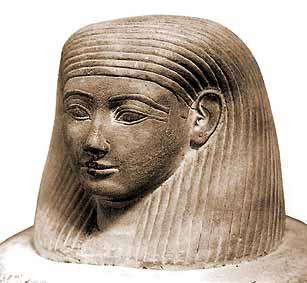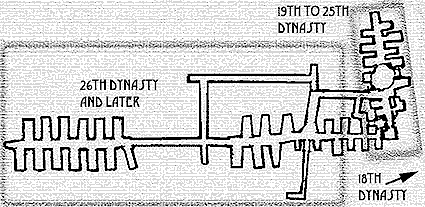 |
|
 |
|
Re-discovery of the Tombs of the Apis Bulls
Strabo, the Greek geographer (63BC - AD22), noted that when he visited Egypt that the Apis Bulls were buried in an underground chamber called the Serapeum, at the end of a paved avenue flanked by stone sphinxes which was constantly being buried in sand and was difficult to visit even then.
The tombs of the Apis were lost for centuries until on the 2nd of October 1850 a 29 year old Frenchmen called Auguste Mariette was sent by the Louvre Museum to Egypt to buy Coptic, Ethiopic and Syriac manuscripts. Whilst for the authorities in Egypt to release the documents Mariette gradually noticed many large stone sphinxes decorating the gardens of large houses in Cairo, after many enquiries about the sphinxes he was directed to the necropolis of Saqqara. Walking around the great Step Pyramid complex of Djoser he found a stone sphinx - its head and paws just standing clear of the sand, after commenting on it he was told it was nothing very exciting as many others had been found laying in sand nearby. Fortunately Mariette remembered the words of Strabo and summoned workmen to dig for him - in all 140 sphinxes were found in a wide avenue which after leading a quarter of a mile into the desert a stepped entrance was discovered leading to an underground chamber . . .
Mariette later recalled the day he rediscovered the Serapeum on the 27th October 1850, here he describes finding a sphinx half buried in the sand, 'Just at that moment, a passage from Strabo flashed through my mind: "There is also a Serapeum at Memphis, in a place so very sandy that dunes of sand are heaped up by the winds; and by those some of the sphinxes I saw were buried even to the head and others were half visible; from which one might guess the danger if a sand-storm should fall upon a man travelling on foot towards the temple"'. Mariette then continued, 'It almost seems that Strabo wrote that - more than eight centuries ago - precisely as a way of helping us find the famous temple to Serapis. Indeed, there could be no doubt about it: that buried sphinx, the companion to fifteen others I had seen in Alexandria and in Cairo, clearly formed part of an avenue leading to the Serapeum at Memphis! In that instant I forgot my misson, forgot the patriarch, the monasteries, the Coptic and Syriac manuscripts. And so, 1 November 1850 dawned, bringing with it one of the most beautiful sunrises I have ever seen in Egypt, and thirty-odd workmen assembled, by my orders, near that sphinx which would so radically alter the conditions of my first stay in Egypt'.
'When I first entered the tombs of the Apis, I was so overwhelmed with astonishment that even now, five years later, the feeling is still vivid in my mind'.
The full account of Mariette's discovery can be read here
Inside the Serapeum
On the wall facing the entrance, regular shaped niches show were stelae were placed by pilgrims visiting the site. Galleries then move to the left and the right which are almost 7.6m (25ft) high and on both sides of these 'main corridors' are side chambers - these side chambers have the floor cut 1.5m (5ft) lower than the main corridor. It is in these side chambers that the massive stone sarcophagi belonging to the Apis Bulls once stood. Each of these sarcophagi was carved from a single block of granite or diorite, the lids alone were more than 30cm (12in) thick - the total sarcophagus weighs more than 80 tons. One of the last sacophagus moved in to place was left in the main chamber with its lid abandoned in one of the chambers. On the sarcophagus was the following text:
'The King Amasis. He has caused this to be made for his memorial of the living Apis, this huge sarcophagus of red granite, for his Majesty approved the custom, that all kings in all ages had had such made of costly stones. This did he, the bestower of life for ever'.
When Mariette first entered, it appeared that all the sarcophagi had suffered at the hands of tomb robbers in antiquity, the lids had been pushed to one side and the contents removed and stripped. However, Mariette found a bricked-up gap - 'Three thousand years had had no effect on it. The fingermarks of the last Egyptian who put the last stone in place, were still visible in the mud plaster. In a corner, bare feet had left their mark in soft sand; nothing was disturbed'. Behind the wall was one remaining sarcophagus the lid intact - the mummy from this sarcophagus is the only remaining example to survive intact to the present day (although Mariette did resort to using dynamite to blow the sarcophagus lid off....).

The head of an Apis Bull Canopic Jar
Prince khaemwese - builder
The earlier chambers of the Serapeum were built by Prince Khaemwese, a son of Ramesses II (Prince Khaemwese has also been thought to of been the architect behind KV5). After his death the Prince was buried alongside the Apis Bulls inside the Serapeum itself, fortunately the ceiling had collapsed onto his sarcophagus hidding it until in 1852 Mariette thought he had found his intact mummy. What looked like the elderly prince lay in a wooden coffin with a gold mask over his face and jewels about his body (however the bones were that of a bull arranged into a human-type shape).
Apis Bulls before Ramesses II
Before the Serapeum was built under Ramesses II (and further extended by succeeding dynasties), previous dynasties had built other tombs to house the Apis Bulls (but these were not built to the same scale). However, Apis Bulls (as has been previously noted above) had been worshipped for thousands of years before the Serapeum was built - especially in the early dynasties - their burial places have never been found, it is thought that these burials still lie hidden under the Saqqarian sands.

Inscribed stelae to the Apis Bulls
The Serapeum has provided many examples of stela showing the varying degree of Apis worhsip from both royal and private persons which may be simple expressions of faith to the more formal record of the death of the bull.
Construction and restoration of the Serapeum in ancient times
Besides the embalming and funeral ceremony, the pharaohs also had to find money for not only the construction of new tombs but also the restoration of earlier burials. A memorial tablet from the time of Ptolemy II gives the following data:
| . |
Working |
time |
|
| . |
|
|
|
|
From the year 32, 21st Payni, to the year 33, 1st Paophi, - excavating the chamber. . . |
|
|
|
|
From the year 33, 4th Paophi, to the year 33, 9th Pharmuthi, finishing the same. . . |
|
|
|
| In the year 37, 8th Mesori, transport of sarcophagus; time . . . |
|
|
|
| In the year 38, 17th Athyr, the completion of the whole edifice; time . . . |
|
|
|